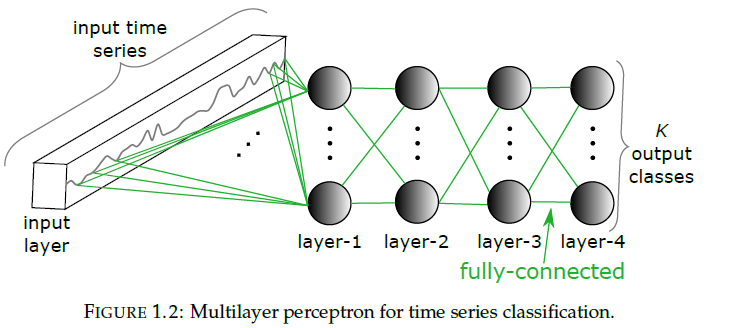Deep Learning For Time Series Classification (2018, 1191)
Contents
-
Introduction
-
SOTA of TSC
- Background
- DL for TSC
- Generative / Discriminative approaches
-
Benchmarking DL for TSC
( 9 methods )
0. Introduction
Tasks
- 1) forecasting
- 2) anomaly detection
- time series outlier detection
- common application : predictive maintenance
- ex) predicting anomalies in advance, to prevent potential failures
- 3) clustering
- ex) discovering daily patterns of sales in Marketing DB
- 4) classification
- data point itself is a “whole time series”
Review about TSC with DL
- different techniques to improve accuracy
- ex) regularization / generalization capabilities
- transfer learning
- ensembling
- data augmentation
- adversarial training
- ex) regularization / generalization capabilities
- test on dataset…
- UCR/UEA archive ( 85 univariate TS )
2. SOTA of TSC
Question :
- Q1) SOTA DNN for TSC?
- Q2) Approach that reaches SOTA, less complicated than HIVE-COTE?
- Q3) How does random initialization affect performance?
- Q4) How about Interpretability?
(1) Background
Notation
-
\(X=\left[x_{1}, x_{2}, \ldots, x_{T}\right]\) : univariate
-
\(X=\left[X^{1}, X^{2}, \ldots, X^{M}\right]\) : multivariate
-
# of dimension : \(M\)
- \[X^{i} \in \mathbb{R}^{T}\]
-
-
\(D=\left\{\left(X_{1}, Y_{1}\right),\left(X_{2}, Y_{2}\right), \ldots,\left(X_{N}, Y_{N}\right)\right\}\) : dataset
- \(X_{i}\) : could either be a univariate or multivariate
- \(Y_{i}\) : one-hot label vector ( \(K\) classes )
(2) DL for TSC
Focus on 3 main DNN architetures
- 1) MLP
- 2) CNN
- 3) ESN
(a) MLP
- input neuron : \(T \times M\) values

(b) CNN
- result of convolution on \(X\) can be considered as “another univariate TS” \(C\)
- thus, applying several filters \(\rightarrow\) MTS!
- unlike MLP, share weights!
- # of filters = # of dimension in MTS
- Pooling
- local pooling : average/max
- global pooling : TS will be aggregated over “whole” TS, resulting in single value
- drastically reduce parameters
- Normalization
- quick convergence
- Batch normalization
- prevent internal covariance shift

(c) ESN
RNN : not widely used for TSC, due to…
- 1) designed mainly to “predict an output for EACH ELEMENT”
- 2) vanishing gradient problem
- 3) hard to train & parallelize
ESNs (Echo State Networks) :
-
mitigate challenges of RNNs, by eliminating the need to compute the gradient of hidden layers
\(\rightarrow\) reduces training time
-
sparsely connected random RNN

(3) Generative / Discriminative approaches
(a) Generative
pass
(b) Discriminative
feature extraction methods
- ex) transform TS to image!
- 1) Gramian fields
- 2) Reccurence Plots
- 3) Markov Transition Fields
in contrast to feature engineering…“End-to-End” DL
- incorporate feature learning process!
2. Benchmarking DL for TSC
limit experiment to “End-to-End Discriminative DL models for TSC”
\(\rightarrow\) chose 9 approaches
(1) MLP
pass
(2) FCNs
pass
(3) Residual Network

(4) Encoder
2 variants
- 1) train from scratch ( end-to-end )
- 2) use pre-trained model & fine-tune
3 layers are convolutional
replace GAP to attention

(5) MCNN ( Multi-scale CNN )
very similar to traditional CNN
but, very complex with its “heavy data preprocessing step”
-
step 1) WS method as data augmentation
- slides a window over input TS
-
step 2) transformation stage
- a) identity mapping
- b) down sampling
- c) smoothing
“transform UNIVARIATE to MULTIVARIATE”
class label is determined by majority vote over extracted subsequences!

(6) Time Le-Net

(7) MCDCNN ( Multi Channel Deep CNN )
traditional CNN + MTS
- convolutions are applied “independently (in parallel)” on each dimension

(8) Time-CNN ( Time Convolutional Neural Network )
for both “UNI-variate” & “MULTI-variate”
use MSE, instead of CE
- \(K\) output nodes ( with sigmoid activation function )

(9) TWIESN ( Time Warping Invariant Echo State Network )
pass
